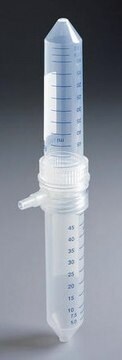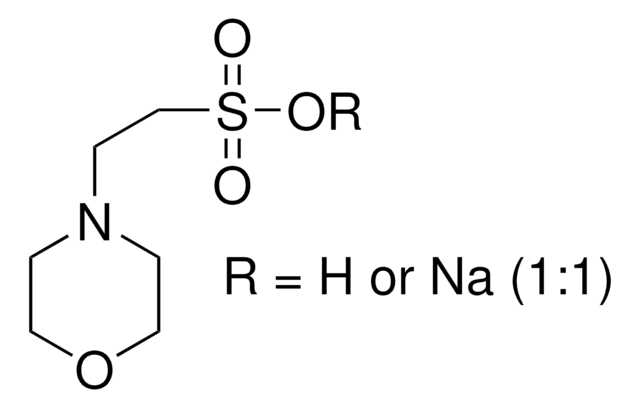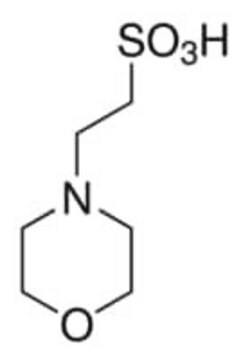69889
MES
BioUltra, for molecular biology, ≥99.5% (T)
Sinônimo(s):
Ácido 2-(N-morfolino)etanossulfônico, Ácido 4-morfolino-etanossulfônico
About This Item
Produtos recomendados
grau
for molecular biology
Nível de qualidade
linha de produto
BioUltra
Ensaio
≥99.5% (T)
forma
powder or crystals
Impurezas
DNases, none detected
Insoluble matter, passes filter test
Phosphatases, none detected
Proteases, none detected
RNases, none detected
resíduo de ignição (900 °C)
≤0.05% (as SO4)
pH
2.5-4.0 (25 °C, 0.5 M in H2O)
faixa de pH útil
5.5-6.7
pKa (25 °C)
6.1
pf
>300 °C (lit.)
solubilidade
H2O: 0.5 M at 20 °C, clear, colorless
densidade
10.66 g/mL
traços de ânion
chloride (Cl-): ≤50 mg/kg
sulfate (SO42-): ≤50 mg/kg
traços de cátion
Al: ≤5 mg/kg
As: ≤0.1 mg/kg
Ba: ≤5 mg/kg
Bi: ≤5 mg/kg
Ca: ≤20 mg/kg
Cd: ≤5 mg/kg
Co: ≤5 mg/kg
Cr: ≤5 mg/kg
Cu: ≤5 mg/kg
Fe: ≤5 mg/kg
K: ≤50 mg/kg
Li: ≤5 mg/kg
Mg: ≤5 mg/kg
Mn: ≤5 mg/kg
Mo: ≤5 mg/kg
Na: ≤50 mg/kg
Ni: ≤5 mg/kg
Pb: ≤5 mg/kg
Sr: ≤5 mg/kg
Zn: ≤5 mg/kg
λ
0.5 M in H2O
Absorção UV
λ: 260 nm Amax: 0.025
λ: 280 nm Amax: 0.020
cadeia de caracteres SMILES
O.OS(=O)(=O)CCN1CCOCC1
adequação
suitable for DNase I test
suitable for Western blot
suitable for molecular biology
aplicação(ões)
clinical research
diagnostic assay manufacturing
life science and biopharma
atividade externa
DNase, none detected
NICKase, none detected
RNase, none detected
protease, none detected
InChI
1S/C6H13NO4S.H2O/c8-12(9,10)6-3-7-1-4-11-5-2-7;/h1-6H2,(H,8,9,10);1H2
chave InChI
MIIIXQJBDGSIKL-UHFFFAOYSA-N
Procurando produtos similares? Visita Guia de comparação de produtos
Categorias relacionadas
Descrição geral
Aplicação
- In the preparation of a solution used for the suspension and dilution of protoplasts to measure the density and number of protoplasts using a haemocytometer
- As a component of Murashige and Skoog basal salt media
- In the preparation of total ionic strength adjustment buffer (TISAB)
- as a constituent in mobile phase solutions employed for the analysis of high molecular weight species and charge-related variants of biopharmaceutical proteins through SEC, HIC, and IEX chromatographic techniques
Características e benefícios
- Suitable as a Buffer component, for Electrophoresis and Molecular Biology
- Effective Buffering from pH 2.5-4.0 (25 °C, 0.5 M in H2O) with a pKa of 6.1 (25 °C)
- Free from DNase, NICKase, RNase, and Protease
Nota de preparo
Outras notas
Sterilization: Sterilization should be by filteration through 0.2 uM filters. Autoclaving is not recommended by any sulfonic acid buffers. If buffers must be nuclease-free, it is best to treat the water, and then add the buffer solids after autoclaving. When MES solutions are autoclaved, they turn yellow (although pH does not change measurably. The identity of the yellow breakdown product is unknown.
Código de classe de armazenamento
11 - Combustible Solids
Classe de risco de água (WGK)
WGK 1
Equipamento de proteção individual
dust mask type N95 (US), Eyeshields, Gloves
Escolha uma das versões mais recentes:
Já possui este produto?
Encontre a documentação dos produtos que você adquiriu recentemente na biblioteca de documentos.
Os clientes também visualizaram
Nossa equipe de cientistas tem experiência em todas as áreas de pesquisa, incluindo Life Sciences, ciência de materiais, síntese química, cromatografia, química analítica e muitas outras.
Entre em contato com a assistência técnica







